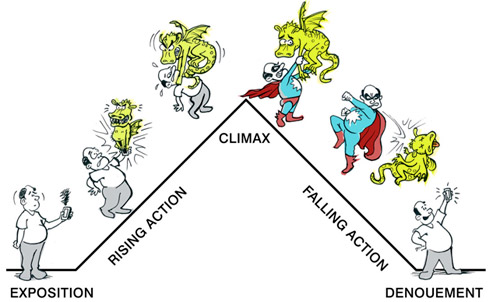The setup of a novel can be extremely complex, sometimes involving subplot and interconnected storylines. But, at their core, the most stories can be broken down based on Freytag’s Pyramid, the classic three-act structure.
Though not every book, short story, or screenplay follows this formula, it is the most common one out there. This is the structure you were introduced to in your English class. It comprises of the set-up, the rising action, and the resolution (with the denouement). Today we are going to examine all three of these acts in an effort to help you better organize your story.
Act One: The Set-Up
The first act is where you establish the exposition of your story. This includes any background, character traits and description, relationships, who the main characters are and what world they live in. After all of that is established, the inciting incident marks the end of the first act. The inciting incident must meet the following criteria:
Signals the end of the set-up
Undoubtedly changes the lives of the protagonists
Asks a question that will eventually be answered in the climax
Must be witnessed or participated in by the protagonists
The inciting incident should invoke what is known as the dramatic question: What do the protagonists have to do to solve the problem they face? Once the inciting incident has occurred and the dramatic question asked, the story moves to act two.
Act Two: The Rising Action and Climax
The second act is where the protagonists are faced with continuous conflict and must grow to try and overcome the antagonist. This is traditionally seen as the character arc as the protagonists learn about themselves and the abilities that they might not know they have. An important aspect to the rising action is the notion that the protagonists cannot grow individually, but should be aided by companions or mentors.
It is important to keep in mind that, though Freytag's Pyramid can be divided into three acts, these three acts do not need to be even in length. It could take two chapters to reach the inciting incident, then most of your novel could be filled with rising action. Alternatively, the rising action could be smaller than the exposition in act one.
The end of the second act is signalled by a second turning point, the first being the inciting incident, that marks the start of the climax.
Act Three: The Resolution
The third and final act in the traditional structure is the resolution. This includes the falling action that results from the climax, the resolution of our dramatic question, and the denouement that follows.
Just because it is called “falling action” does not mean that it is in any way boring. Falling action is the fallout of the climax. Perhaps your protagonist and antagonist square-off to mark the climax, but the war is still waging in the falling action. Perhaps your main character and her army knock down the castle walls in the climax, but they still must find and usurp the tyrant to come to the resolution.
The resolution itself is the answer to your central question. It is the thing that your protagonists have been striving for the entire novel and either they fail or succeed in their mission. But even with the resolution completed, there is surely more threads that need tying.
In the denouement, stories and subplots should be mostly wrapped up. If there is a sequel to the story, then questions that are unanswered can be asked again, while cliffhangers might be invoked. Most importantly, the characters should gain a new sense of self during the denouement. Every story is about the growth of your main characters, so make sure to show the result of that growth.
The three-act structure, the basis of Freytag’s Pyramid, can be traced back to Aristotle and his concept of beginning, middle, and end. It is a timeless way of telling stories and one that will undoubtedly endure well beyond us.
But the three-act structure is not the only way of building your plot. On Thursday we will look at alternative, non-traditional forms of structuring your story. When it comes to your art, one size never fits all.
Leave a comment below with your thoughts on the three-act structure: do you love it? Do you hate it? Does your story fit into the three acts and, if so, what are your inciting incidents, your rising action, and your climax? Let us know in the comments below!
As always, happy writing my friends. I will see you on Thursday.



